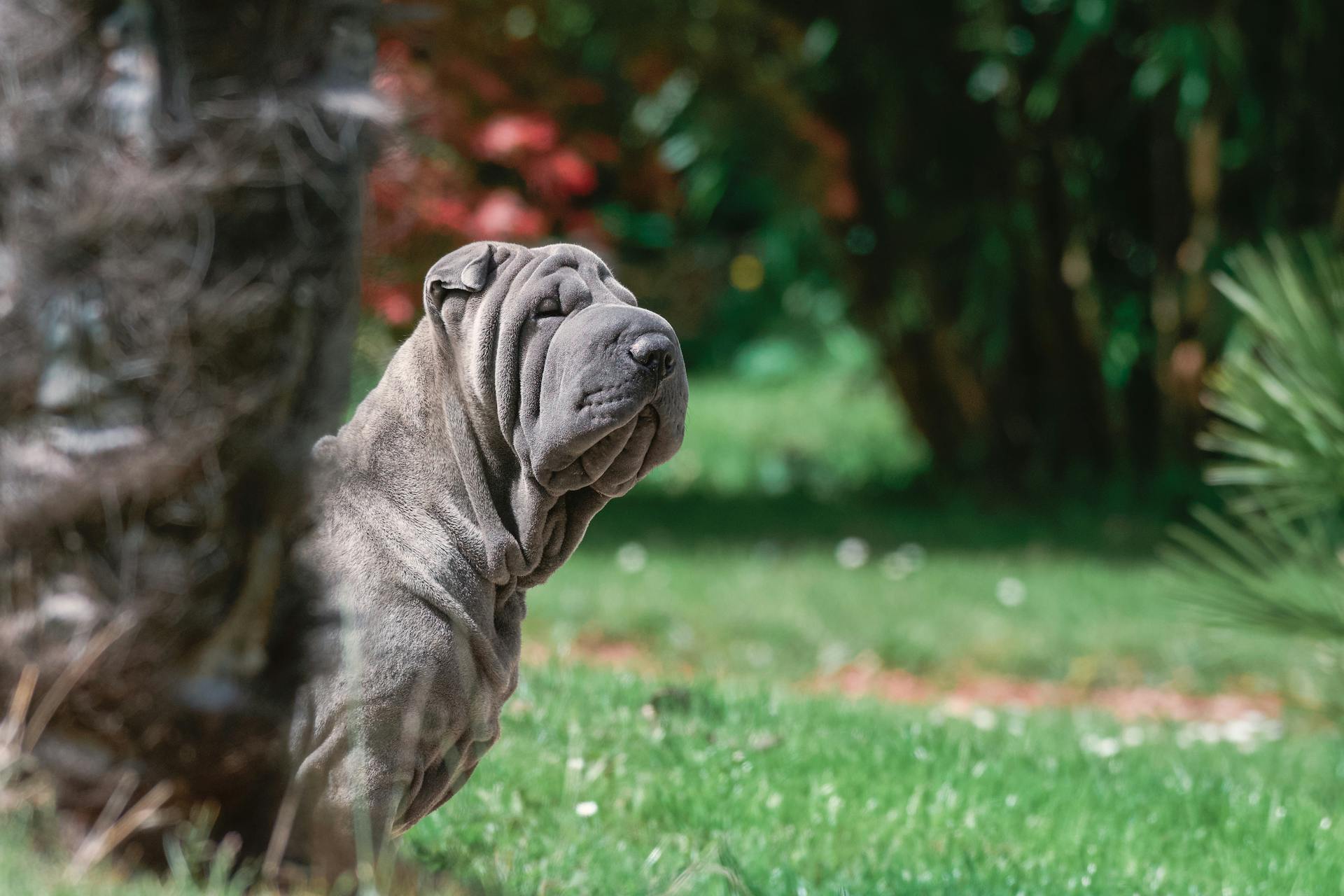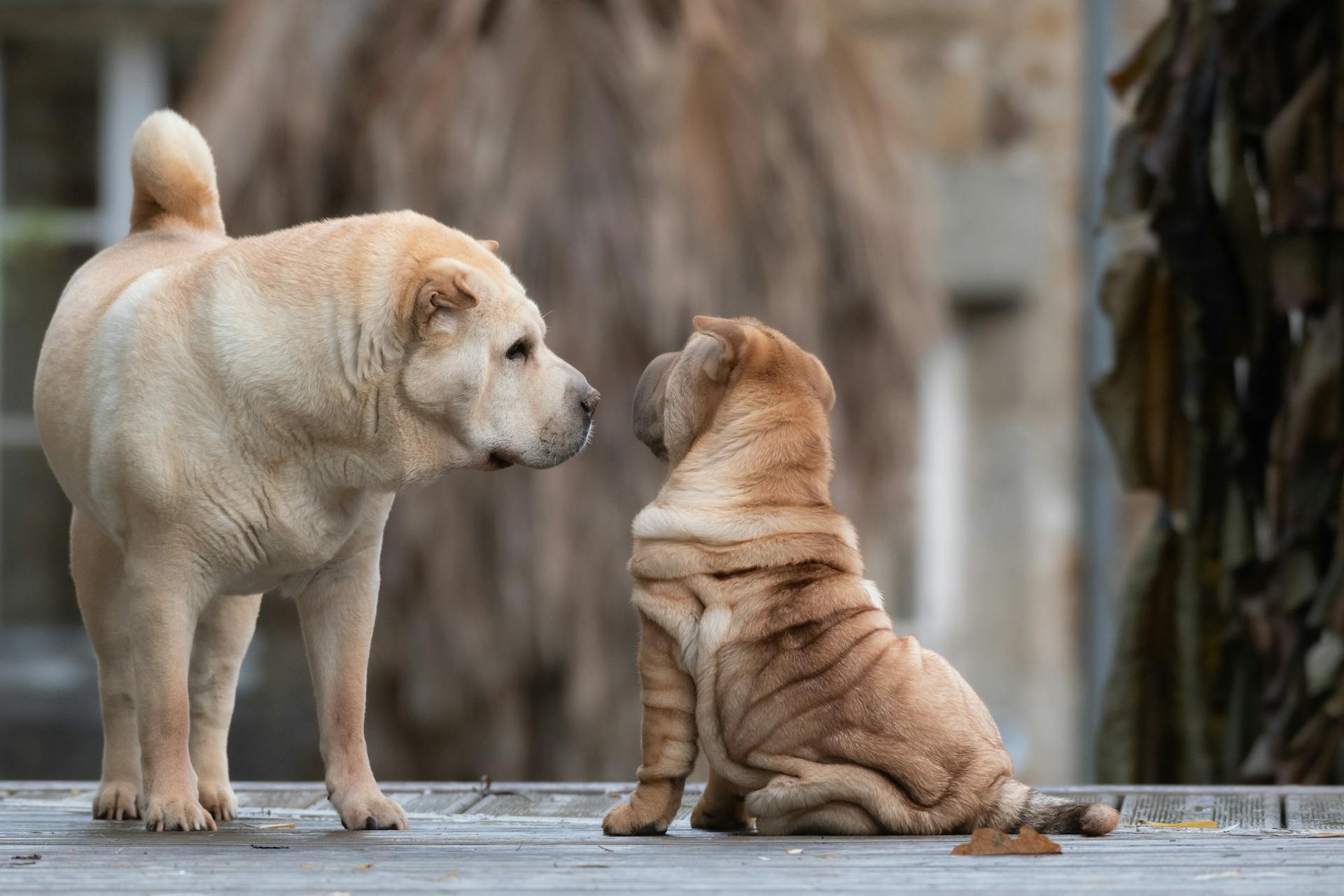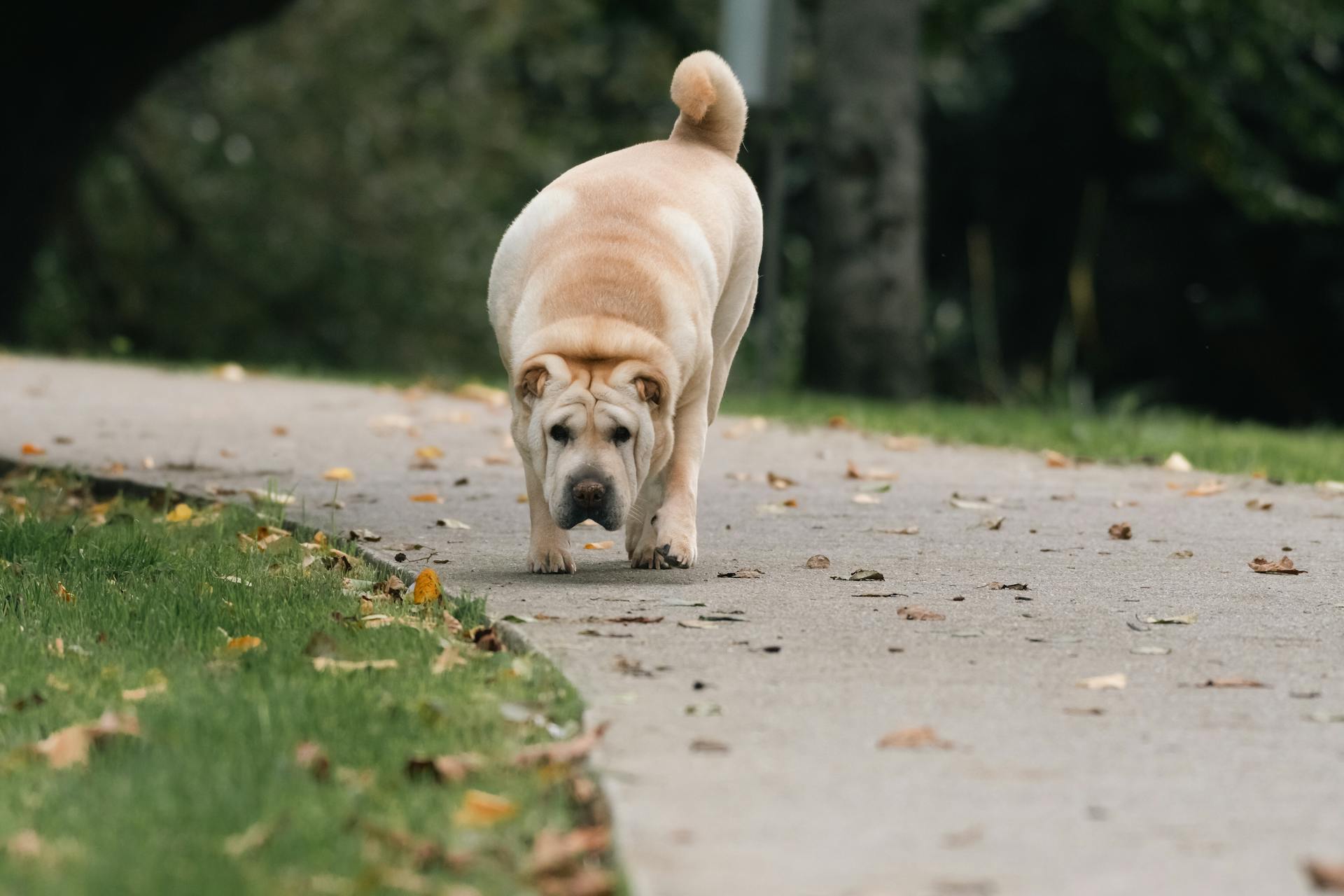
The Flowered Chinese Shar Pei is a unique and lovable breed, known for its distinctive wrinkled skin and gentle nature. They originated in China over 2,000 years ago.
Their short, easy-to-maintain coats come in a variety of colors, including sable, cream, and fawn. They're a relatively small breed, weighing between 25-35 pounds.
One of the most distinctive features of the Flowered Chinese Shar Pei is its skin folds, which can be quite deep in some individuals. These skin folds need to be regularly cleaned to prevent skin infections.
Their calm and affectionate nature makes them a great breed for families with children.
Recommended read: Chinese Shar Pei Skin Problems
Chinese Origins
The Chinese Shar-Pei has a rich history that spans centuries, and it's fascinating to learn about its origins. They originated in China, specifically in the Southern part of the country in a village called Tai Li.
Their existence dates back to the Han Dynasty, around 206 BCE–220 CE, where evidence of their existence can be seen in the form of statues. The Shar-Pei is one of 14 of the oldest breeds recognized by the AKC.
A translated 13th-century Chinese manuscript describes the characteristics of this breed, further pointing to the long existence of the Chinese Shar-Pei. This manuscript is a more recent find, but it provides valuable insight into the breed's history.
The Shar-Pei wasn't recognized by the AKC until 1992, but the breed has been around for centuries in southern China. Statues from the Han Dynasty show a wrinkled dog that resembles a Shar-Pei.
Temperament & Intelligence
The Shar Pei's temperament is a unique blend of loyalty and independence. They're often described as "cat-like" in their behavior, meaning they'll come and cuddle on their own terms.
Shar Peis are highly intelligent animals that require consistent training and socialization from an early age. They can be wary of strangers and may exhibit aggression if not properly trained.
With proper training and socialization, Shar Peis can form strong bonds with their owners and become loving companions. However, they may struggle to understand that strangers are not a threat.
Shar Peis are naturally protective of their family and may mistake play for aggression. They need to be taught the distinction between play and threats early on.
They're not suitable for first-time dog owners and require an experienced owner who can handle their strong will and protective nature.
Shar Peis can be anxious and fearful dogs if not socialized properly, leading to unwanted behaviors such as aggression and destructive behavior.
Consistency, patience, and positive reinforcement are key when training a Shar Pei. They may not respond to commands immediately, but with time and effort, they can learn to listen and behave well around strangers.
Suggestion: Bernese Mountain Dog Guard
Care and Maintenance
Shar Peis are a relatively low-maintenance breed when it comes to grooming, but they do require regular care to stay healthy.
Their coats are easy to maintain, but they do need occasional baths, especially during pollen season, to prevent allergies. Make sure to clean between the folds to keep them clean.
You'll also need to watch for skin, ear, and eye issues, as Shar Peis are prone to these problems. Regular evaluations with your veterinarian will help you catch any issues early on.
Trim their nails once or twice a month, and introduce them to teeth brushing early on to prevent dental problems.
Exercise
Exercise is essential for Shar Peis, and they require moderate to high amounts of it.
They can be hyper and desire to run long and far when they're feeling peppy, so it's best to have a large, fenced-in secure area.
You can take them on brisk daily walks, which is a great way to get some exercise together.
Most adult Shar Peis require no more than 60 minutes of solid exercise per day.
You can break that up how you see fit and engage in your dog's favorite activities, like playing games in the yard.
Food & Diet
Shar Peis can be sensitive to certain ingredients in their food, which can cause skin issues and allergies. They're particularly prone to yeast and ear infections, so regular ear inspections are a must.

Try to avoid dog food with preservatives, artificial ingredients, and chemical compounds. Instead, opt for a high-quality, protein-rich diet that's tailored to their life stage.
Puppies need a puppy chow with DHA and glucosamine or chondroitin to support muscle and bone growth. This is crucial for their development.
As they enter adulthood, you can switch to an adult formula that helps them manage their weight and energy levels.
Grooming
Grooming is a crucial part of shar-pei care, and they're not the low-maintenance type. Their coats don't shed much, but they do blow coat a couple of times a year.
You'll need to bathe your shar-pei every 4 to 6 weeks, and don't forget to clean between the folds! This will help prevent skin issues and keep them smelling fresh. Regularly cleaning their wrinkles is also a must to prevent bacteria and infection.
Their coats don't require much brushing, but be prepared to clean up puppy fur on your furniture as they shed year-round. You can use a rubber curry or grooming mitt for a quick brush, making it a breeze to keep them looking their best.
Don't forget to trim their nails once or twice a month - if you hear nails clicking on the floor, they're too long! And introduce them to teeth brushing early on, like during puppyhood, to make it a lifelong habit.
Intriguing read: Do Border Collies Moult
Health and Wellbeing
The flowered Chinese Shar Pei is a beautiful and unique breed, but like all dogs, they require regular veterinary care to stay healthy.
Their typical lifespan is 8-12 years, which is a good amount of time to enjoy their loving companionship.
To ensure your Shar Pei stays healthy, you should schedule regular check-ups with your vet, starting from their first year. They'll need parasite prevention, deworming, spaying or neutering surgery, and microchipping.
There are several health conditions to be aware of, including skin fold disease, pododermatitis, hypothyroidism, and familial Shar Pei Fever.
Here are some common health issues that can affect Shar Pei:
- Hip, elbow, and patella concerns
- Primary lens luxation (a genetic disease that can cause blindness)
- Shar Pei Fever (a breed-specific illness that causes periodic fevers and swollen hock joints)
- Cutaneous mucinosis (a skin disorder that can be treated with steroids)
- Mast cell tumors
- Malignant melanoma of the tongue
It's essential to work with reputable breeders who can provide health records, screenings, and certifications for your puppy. They should also be available to answer questions and provide ongoing support for your new furry friend.
Interesting Facts
The literal translation of shar-pei is "sand skin", which tells you a lot about what to expect when you pet their rough, sandpapery coat.
In China, where the breed originated, the blue-black shar-pei tongue and wrinkly skin were believed to frighten away evil spirits.
One of the most interesting things about shar-peis is their unique appearance, which is a result of their sandpapery coat and wrinkly skin. This makes them stand out from other dog breeds.
Here are some fun facts about shar-peis that might interest you:
- Their rough coat is a result of their sandpapery skin, which was literally translated as "sand skin."
- They were believed to have spiritual significance in China, with their blue-black tongue and wrinkly skin thought to ward off evil spirits.
- In 1983, a pair of his and hers shar-pei puppies were listed as fantasy gifts for $2000 a piece in the Neiman Marcus Christmas Book.
12 Dog Facts
Dogs are incredibly social animals, with some breeds forming close bonds with their human families in as little as 30 minutes.
Dogs have a unique nose print, just like humans have fingerprints, and no two nose prints are alike.
Their sense of smell is incredibly powerful, with some dogs able to detect scents that are 10,000 times weaker than what humans can detect.
Some dogs are natural-born athletes, with Greyhounds being the fastest dog breed, reaching speeds of up to 45 miles per hour.
Dogs have a strong instinct to follow their pack, which is why they often get anxious when left alone for long periods of time.
Their ears are incredibly sensitive, with some dogs able to hear sounds at frequencies as high as 40,000 Hz.
Dogs have a unique way of communicating with each other through body language, with a wagging tail often indicating excitement or friendliness.
Some breeds are naturally more intelligent than others, with Poodles being one of the smartest dog breeds, known for their ability to learn quickly and easily.
Dogs are able to learn and adapt quickly, with some studies showing that dogs can learn up to 1,000 words and commands.
3 Shar-Pei Facts
The Shar-Pei is a unique and fascinating breed. Their skin folds can trap water and debris, making regular cleaning a must.
One Shar-Pei fact is that they were originally bred as working dogs in China. Their distinctive wrinkles require regular cleaning to prevent skin infections.
The Shar-Pei's short coat sheds minimally, but they still need regular grooming to prevent matting.
Fun Facts
The Shar-Pei breed has some fascinating characteristics. The literal translation of "Shar-Pei" is "sand skin", which gives you an idea of what to expect from their rough, sandpapery coat.

In China, where the breed originated, the blue-black Shar-Pei tongue and wrinkly skin were believed to have spiritual significance. They were thought to frighten away evil spirits, which adds a unique layer of cultural history to this breed.
Shar-Pei puppies have been quite the luxury item in the past. In 1983, a pair of his and hers Shar-Pei puppies were listed as fantasy gifts for $2000 a piece in the Neiman Marcus Christmas Book.
Here are some fun facts about the Shar-Pei breed:
- The literal translation of Shar-Pei is "sand skin".
- In China, the blue-black Shar-Pei tongue and wrinkly skin were believed to frighten away evil spirits.
- In 1983, a pair of his and hers Shar-Pei puppies were listed as fantasy gifts for $2000 a piece in the Neiman Marcus Christmas Book.
Owning a Shar Pei
Owning a Shar Pei requires careful consideration of their unique needs and characteristics. Shar Pei puppies are intelligent and active, so be prepared for a curious and playful companion.
To ensure a smooth transition, it's essential to select a reputable breeder with a history of successful, healthy litters and sound temperaments. This will help minimize the risk of aggression issues.
Shar Peis are generally good with families and seniors, but they can be aloof and willful at times. With proper socialization and training, you can channel their instincts and develop a strong bond with your pet. They are highly territorial, so be prepared for a strong loyalty and protection instinct.
Here are some essential traits to consider when owning a Shar Pei:
Remember, Shar Peis are prone to health issues, so regular veterinary check-ups and a balanced diet are crucial to maintaining their overall health and well-being.
Shar Pei Puppies
Shar Pei puppies are the cutest things you've ever seen, with incredibly soft, fluffy fur and very movable wrinkles when they're very small.
They're active, curious, and ready to explore new things, making them a joy to watch and interact with.
You'll get a lot of compliments on your little pup's unique looks, and they're intelligent, so you shouldn't have a lot of issues with potty training and basic commands.
It's crucial to select a reputable breeder, especially since the Shar Pei can show aggression, so choose one with a history of successful, healthy litters with sound temperaments.
Owning a Shar-Pei
A Shar-Pei can live up to 12 years, which is a long time to enjoy the companionship of this loyal friend.
Shar-Pei puppies are active, curious, and intelligent, making them relatively easy to train.
To ensure your Shar-Pei grows into a well-adjusted adult, it's essential to provide plenty of early socialization.
A Shar-Pei's lifespan can be influenced by their genetic predisposition to health issues, so regular veterinary check-ups are crucial.
Shar-Pei puppies are best raised by experienced breeders who have a history of producing healthy, well-tempered litters.
If you're prepared to invest time and effort into training and socializing your Shar-Pei, you'll be rewarded with a loyal companion.
Shar-Peis are highly territorial and can be prone to chewing, so be prepared to Shar-Pei-proof your home.
Here's a summary of the Shar-Pei's key characteristics:
Shar-Peis are generally good with families and seniors, but their independent nature means they may not always be eager to please.
Frequently Asked Questions
What is the rarest color of Shar-Pei?
There is no such thing as a rare Shar-Pei color, as the breed naturally comes in a wide variety of hues. However, some less common colors may be considered unique by enthusiasts.
Featured Images: pexels.com


